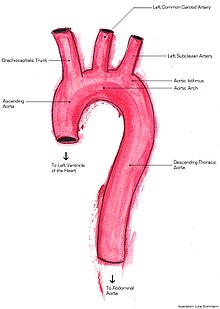|
Penetrating atherosclerotic ulcer
A penetrating atherosclerotic ulcer (PAU) is an atherosclerotic lesion that ulcerates, leading to a hematoma forming within the walls of the aorta.[1] Cause
DiagnosisThe condition is often associated with thickening of the aortic wall, and can be differentiated from similar conditions (atherosclerotic plaque and a thrombus) through the use of computed tomography and magnetic resonance imaging, though the latter is superior.[2] Transesophageal echocardiography and intravascular ultrasonography may also be used in differentiation.[1] TreatmentComplications such as rupture or other life-threatening conditions are rare. Treatment may involve surgery, particularly when signs indicating worsening are present (the patient is unable to control their pain or changes in blood pressure).[1] Notes
External links |
||||||||||||||
Portal di Ensiklopedia Dunia
